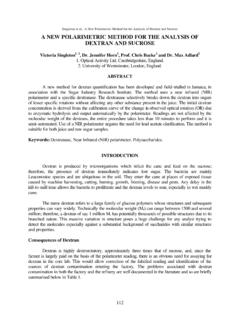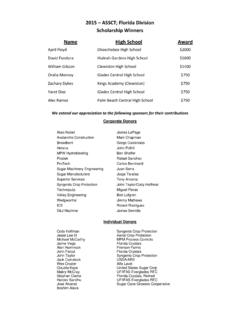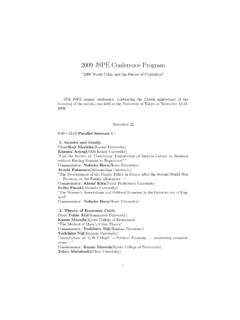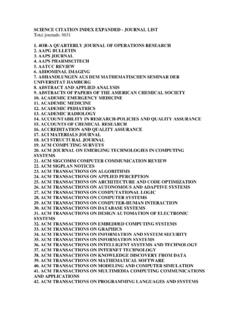Transcription of Survey Estimation of Sugarcane Combine Costs in Louisiana
1 Journal Association Sugar Cane Technologists: 28: 32-41, 2008. REDUCING HARVEST Costs THROUGH COORDINATED Sugarcane . HARVEST AND TRANSPORT OPERATIONS IN Louisiana . Michael E. Salassi* and F. Gil Barker 1. Department of Agricultural Economics and Agribusiness, Louisiana State University Agricultural Center, Baton Rouge, LA 70803. *Corresponding author: ABSTRACT. Harvest Costs represent a major cost item for Sugarcane production in Louisiana and other Sugarcane producing regions in the United States. Projected Costs for Sugarcane production in Louisiana for 2007 show harvest Costs account for percent of total production Costs . One factor which can have a significant influence on harvest cost is the impact of time spent waiting for trucks returning from the mill to arrive at the farm. As the number of trucks arriving at a mill to unload harvested Sugarcane in a given time period increases, the time required for a truck to be sampled, unload and return to the farm increases. A study was conducted to estimate the cost of waiting time on harvest cost and to develop a framework for coordinating harvest and transport of Sugarcane to minimize waiting time.
2 This required the development of a mathematical programming model which could coordinate harvest and delivery schedules to minimize truck waiting time at the mill. Waiting time was estimated to increase farmers harvest cost at a rate of $ per minute. Mathematical programming model results illustrate the ability to coordinate harvest and delivery schedules can reduce truck waiting time at the mill. INTRODUCTION. Harvest Costs represent the single largest farm cost item associated with producing Sugarcane in Louisiana . A breakdown of estimated variable and total Sugarcane production Costs by phase of production are shown in Table 1. Variable cost for the Sugarcane production phases listed includes expenses for seed cane, fuel, labor, fertilizer, chemicals, custom application, repair and maintenance, and interest on operating capital. Total cost includes variable Costs plus fixed Costs , the depreciation and interest expense on machinery and equipment used in production. Some production operations may have a very high cost per hectare, but are conducted over a relatively small number of hectares.
3 For example, the planting of cultured seed cane, which has an estimated total cost of $1,361 per hectare to purchase and load the seed cane and another $763 per hectare cost to hand plant the seed cane in the field, is the most expensive Sugarcane farm operation on a per hectare basis, but is conducted on only a small number of hectares each year. Harvesting, on the other hand, is a relatively lower cost operation, with variable and total Costs estimated at $358 and $595 per hectare, respectively. However, for a typical farm in Louisiana which harvests Sugarcane through a third stubble crop, harvest operations would be conducted on approximately percent of the total farm area, accounting for percent of total farm production Costs . By accounting for such a large share of total farm Costs , improvements in harvesting operations and efficiency would have a significant impact on reducing farm production Costs . 32. Salassi and Barker: Reducing harvest Costs through coordinated Sugarcane harvest and transport operations in Louisiana Table 1.
4 Estimated Sugarcane production Costs for Louisiana , 2007. Percent of Variable cost Total cost Percent of Production phase total farm area per hectare per hectare total cost (%) (dollars/ha) (dollars/ha) (%). Fallow / seed bed preparation 366 600 Cultured seed cane 1,334 1,361 Hand planting cultured seed cane 566 763 Harvesting whole stalk seed cane 165 294 Mechanical planting 501 650 Plant cane field operations 534 652 First stubble field operations 758 892 Second stubble field operations 776 909 Third stubble field operations 776 909 Harvest for sugar operations 358 595 Source: Salassi and Deliberto, 2007. Estimates of harvests Costs from various Sugarcane producing regions have been published, either on an annual or periodic basis. Comparison of published estimates generally indicate that Sugarcane harvest Costs in Louisiana are significantly higher than harvest Costs in major Sugarcane producing regions of the world. Results from a study published in 2006 showed average Sugarcane harvest Costs in Louisiana , based on a Survey of growers, at $ per metric ton (Salassi, 2006).
5 An earlier South African study evaluating performance and utilization of Sugarcane harvest machinery reported harvest Costs ranging from $ to $ per ton of Sugarcane harvested (Meyer, 1999). A study which evaluated a fully mechanized Combine harvest system for several farms in South Africa reported harvest and infield transport Costs ranging from $ to $ per ton (Meyer et al., 2000). Two more recent studies from Australia report harvest Costs ranging between $ and $ per ton for the 2000 harvest season (Higgins and Muchow, 2002) and average harvest Costs ranging from $ to $ per ton over the 1996 to 2002 period (Muscat and Agnew, 2004). One factor which has a significant impact on Sugarcane harvests Costs is the number of hectares over which a machine is utilized. Fixed harvest Costs are associated with the annual Costs of owning the harvest machine. These Costs are primarily comprised of depreciation and interest on investment charges, but can also include insurance and other fixed charge expenses.
6 Fixed cost per unit, either on a per hectare or per tons harvested basis, are reduced as the harvester is used over more hectares. Operation of harvesters over the course of harvest season at less than full harvest capacity will cause fixed Costs per unit to be higher. Another significant factor which affects Sugarcane per-hectare harvest Costs is in-field waiting time incurred by harvest crews waiting for transport trucks to return. As the number of trucks arriving at a mill to unload harvested Sugarcane within a given time period increases, the time required for a truck to be sampled at the core lab, unload in the mill yard, and return to the farm also increases. In some cases, the congestion and resulting increased turnaround time at the mill causes harvest operations at the farm to stop. This possible waiting time increases actual 33. Journal Association Sugar Cane Technologists: 28: 32-41, 2008. harvest Costs per hectare primarily due to the additional fuel and labor Costs associated with the stoppage of harvest operations.
7 Considerable research has been conducted in other Sugarcane -producing countries focusing primarily on optimizing harvest and transport operations. This work has included optimization of harvest group scheduling in Australia (Higgins, 2002), simulation of harvest to mill delivery systems in South Africa (Hansen et al., 2002), economic case study analysis of regional harvest operations in Australia (Higgins et al., 2004), as well as PC-based decision support tools to evaluate alternative harvest and transport situations in Thailand (Singh and Pathak, 1994). Little research has been conducted on the impact of waiting time at the farm on harvest Costs as well as scheduling harvest and mill delivery operations to reduce waiting time impacts. The objective of the research study presented here was to estimate the impact of waiting time on harvest Costs per hectare in Louisiana and to develop a modeling framework which had the capability to optimally schedule Sugarcane harvest and transport operations with the goal of minimizing waiting time at the farm or mill.
8 MATERIALS AND METHODS. The impact of increased waiting time at the farm during harvest operations on Sugarcane harvest Costs was estimated by using published cost estimates and adjusting the performance rate factors for the harvester and wagons to reflect increased waiting time. Current estimated harvest Costs for 2007 were taken from a report by Salassi and Deliberto (2007). Specific operations itemized in the budget included a Combine harvester along with three support tractor and wagon sets. The performance rate specified for the harvester and wagons was hours per hectare, representing the time required to harvest and load into wagons one hectare of Sugarcane . In order to evaluate the impact of increases in waiting time on harvest cost , an analysis was conducted to estimate changes in variable harvest cost resulting from increased waiting time by adjusting the performance rate of harvest operations. This analysis focused on the fuel and labor Costs associated with the harvester and tractors and wagons since these are the cost items most directly impacted by waiting time.
9 To simulate a range of possible waiting times, harvest time was arbitrarily increased from to minutes per hectare (five to twenty minutes per acre). to represent the stoppage of harvest operations to wait for a truck to arrive. This resulted in an adjustment of the harvest performance rate from hours per hectare to values between a range of and hours per hectare. Fuel consumption of the harvester and tractors were adjusted using a factor of 40 percent to reflect idle speed. Labor for the Combine harvester operator was charged at a rate of $ per hour and labor for tractor operators was charged at a rate of $ per hour. Optimization of harvest and transport operations to minimize waiting time was accomplished through the development of a Sugarcane harvest and transport scheduling model. A mathematical programming model was developed which was capable of determining an optimal harvest schedule for a group of farms delivering to a common mill with the objective of minimizing the waiting time of trucks delivering to the mill.
10 The mathematical programming model simulates delivery of harvested Sugarcane by truck and trailer over the course of one day during the grinding season. Alternative harvest starting times were included to represent 34. Salassi and Barker: Reducing harvest Costs through coordinated Sugarcane harvest and transport operations in Louisiana potential harvest schedules available to farms. The objective function of the programming model minimized the sum of truck loads exceeding a specified hourly maximum level over the course of the day. For the specific representative harvesting scenario evaluated, a total of 360 trucks loads were assumed to be delivered per day to the mill, representing approximately 9,143 metric tons (10,080 short tons) of Sugarcane harvested daily. Two farm sizes were simulated in the model: one with six loads per day and the other with twelve loads per day. Each farm was assumed to have one harvester in use. Three distances from farm to mill, in minutes of travel time, were simulated: 15 minutes, 30 minutes and 45 minutes.







